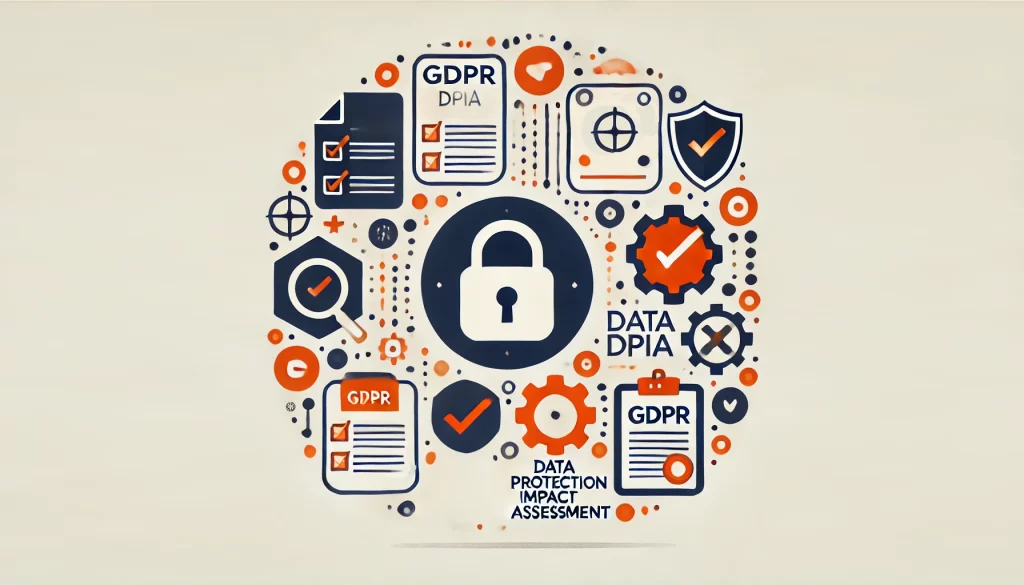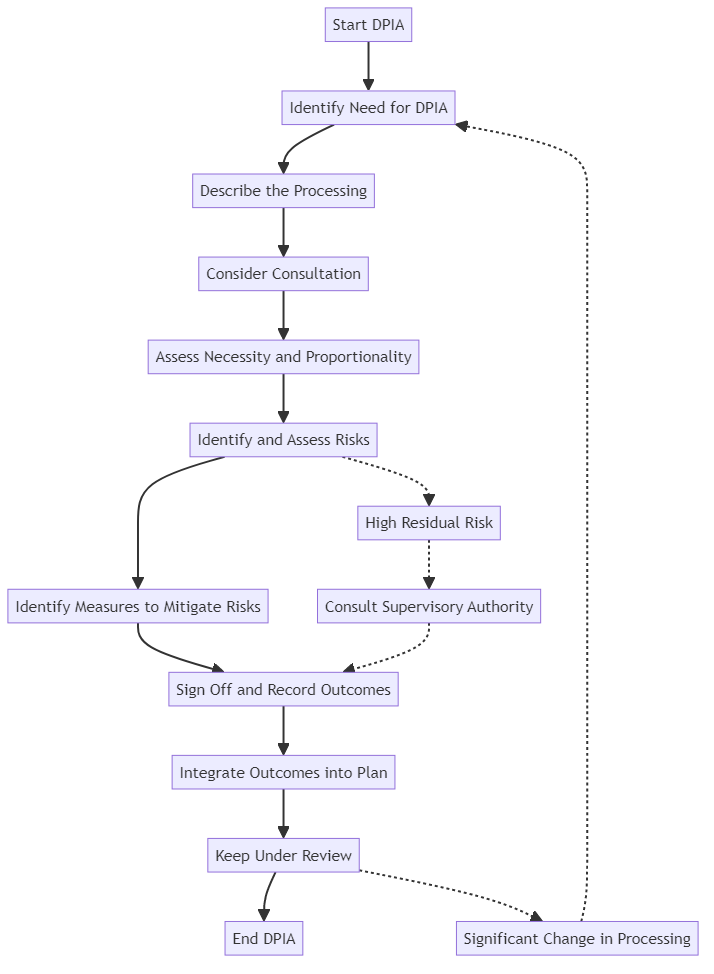
Understanding GDPR DPIA: A Key Tool for Privacy Compliance

The General Data Protection Regulation has significantly changed how organizations handle personal data. One crucial aspect of GDPR compliance is the Data Protection Impact Assessment. DPIAs are essential for organizations processing personal data, especially those dealing with high-risk activities. This article will discuss GDPR DPIA, including their necessity, the process of conducting them, and their benefits.
What is a GDPR DPIA?
A Data Protection Impact Assessment is a tool used to identify and minimize privacy risks in data processing activities. A method that helps organizations follow GDPR rules by checking if data processing is necessary and proportional. A DPIA involves evaluating the risks to individuals’ rights and freedoms and determining measures to address those risks.
When is a GDPR DPIA Required?
Organizations need to do a DPIA when their data processing could pose significant risks to people’s rights and freedoms. The GDPR outlines specific scenarios where a DPIA is mandatory. These include:
- Systematic and extensive profiling with significant effects
- Large-scale processing of special categories of data or criminal convictions
- Systematic monitoring of publicly accessible areas on a large scale
For instance, a healthcare provider using an AI diagnostic system to analyze patients’ records must do a DPIA assessment. This scenario involves large-scale processing of sensitive health data and could significantly impact individuals’ lives.
Beyond Mandatory Scenarios
The GDPR outlines when DPIAs are necessary, but it can be helpful to do them in other situations as well. Organizations should consider performing a DPIA when:
- Introducing new technologies
- Combining different datasets
- Processing children’s data
- Using data for purposes other than those initially collected for
A store wanting to start a loyalty program that tracks what customers buy and where they shop should do a DPIA. Although not explicitly required, this program involves profiling and location tracking, which could pose risks to customers’ privacy.
Steps to Conduct a GDPR DPIA
Conducting a DPIA involves several key steps. Here’s a breakdown of the process:

- Identify the Need for a DPIA
The first step is determining whether a DPIA is necessary. Review your planned data processing activities and assess them against the GDPR criteria for mandatory DPIAs. Even if not required, consider the potential risks to decide if a DPIA would be beneficial.
- Describe the Processing
Provide a detailed description of the data processing activities. This should include:
- The nature, scope, context, and purposes of the processing
- The types of personal data involved
- Who will have access to the data
Seek the views of relevant stakeholders, including data subjects if appropriate. This could involve surveying customers about a new data use or consulting with employee representatives about workplace monitoring.
- Assess Necessity
Evaluate whether the processing is necessary to achieve your objectives and if it’s proportionate to the purpose. Consider if there are less intrusive ways to achieve the same goal.
- Identify and Assess Risks
Analyze the potential impact on individuals’ rights and freedoms. Consider various scenarios and their likelihood. For instance, what would happen if someone breached or misused the data?
- Identify Measures to Mitigate Risks
Develop strategies to address the identified risks. This could include implementing stronger security measures, reducing data retention periods, or enhancing transparency to data subjects.
- Sign Off and Record Outcomes
Document the DPIA process and its outcomes. If residual high risks remain, consult with your authority before proceeding with the processing.
- Integrate Outcomes into Plan
Implement the identified measures and integrate them into your project plan. Ensure that the DPIA findings influence your data processing activities.
- Keep Under Review
A DPIA is not a one-time exercise. Regularly review and update it, especially if there are changes to the processing activities.
Benefits of Conducting a GDPR DPIA
Performing a DPIA offers several advantages beyond mere compliance:
Improved Data Protection
By analyzing data processing activities, organizations can identify potential privacy issues early. This allows for the implementation of protective measures from the start, enhancing overall data protection.
Cost Savings
Addressing privacy concerns at the planning stage is often more cost-effective than making changes later. A DPIA can help avoid costly retrofits or fines for non-compliance.
Enhanced Trust
Demonstrating a commitment to privacy through DPIAs can boost customer and employee trust. It shows that the organization takes data protection seriously.
Better Decision Making
The DPIA process provides valuable insights into data flows and risks. This information can inform better decisions about data handling practices.
Compliance Documentation
A well-documented DPIA serves as evidence of GDPR compliance efforts. This can be crucial if an audit or investigation occurs.
Real-World DPIA Example
Let’s consider a practical example of a GDPR DPIA in action. Imagine a large retail chain planning to implement a facial recognition system in its stores for security purposes.
Step 1: The company uses a lot of biometric data. They monitor a public space regularly.
Step 2: A full explanation of the process takes place. It starts with collecting facial images. The system then converts these images into biometric templates. Finally, store employees use the templates to identify potential shoplifters.
Step 3: The company consults with employee representatives and conducts a survey to gather views on the proposed system.
Step 4: Assess the necessity and proportions. Is facial recognition truly necessary for security, or could less intrusive methods be effective?
Step 5: Problems like false accusations and data theft are risks of hacking the system or it giving incorrect results.
Step 6: We have taken steps to protect your information. These steps include controlling access, encrypting biometric data, and having a strong system for handling errors.
Step 7: Senior management signs off on the DPIA. If certain conditions are met, only then we proceed.
Step 8: We updated the project plan to incorporate the privacy-enhancing measures identified in the DPIA.
Step 9: We create a schedule for regular reviews of the DPIA. We plan to conduct the first review six months after implementation.
Common Challenges in Conducting DPIAs
While DPIAs are valuable tools, organizations often face challenges in implementing them effectively:
Resource Constraints
Conducting a thorough DPIA requires time and expertise. Smaller organizations might struggle to allocate sufficient resources to the process.
Lack of Expertise
DPIAs require a good understanding of both data protection principles and the specific processing activities. Not all organizations have this expertise in-house.
Scope Creep
As projects evolve, the scope of data processing might change. Keeping the DPIA up-to-date with these changes can be challenging.
Balancing Innovation and Privacy
Often a tension exists between leveraging data for innovation and protecting privacy. DPIAs need to navigate this balance carefully.
Overcoming DPIA Challenges
To address these challenges, organizations can:
- Invest in training to build internal DPIA capabilities
- Consider using DPIA tools or templates to streamline the process
- Integrate DPIA considerations into project management methodologies
- Foster a culture of privacy awareness across the organization
The Future of DPIAs
As data processing becomes more complex and widespread, the importance of DPIAs is likely to grow. We can expect to see:
- More sophisticated DPIA tools leveraging AI to identify risks
- Greater integration of DPIAs with other risk management processes
- Increased focus on DPIAs for AI and machine learning systems
- More guidance from regulatory bodies on DPIA best practices
Conclusion
GDPR DPIAs are powerful tools for enhancing data protection and ensuring compliance. By assessing the risks associated with data processing activities, organizations can protect individuals’ privacy rights while still innovating and deriving value from data.
Doing a DPIA may be hard, but it’s worth it for reducing risks, building trust, and following rules. As data processing evolves, DPIAs will be more important in protecting privacy.
